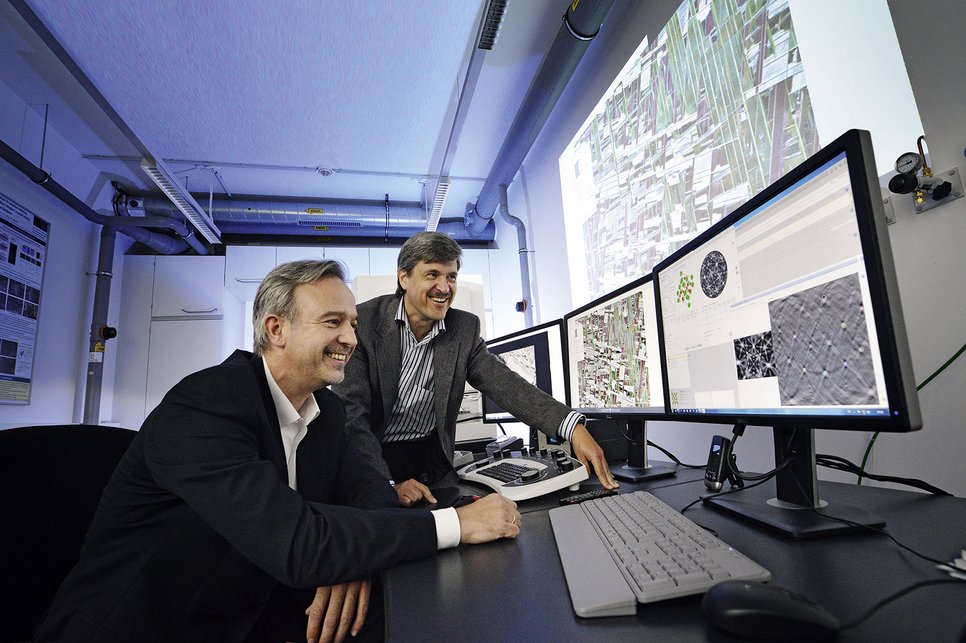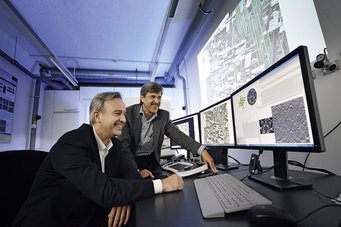
12: The Max-Planck-Institut für Eisenforschung Today
Nowadays, the guiding scientific principle of the institute is the “understanding and design of complex materials in their real environments down to the atomic scale”.

Since 29th September, 2010 Professor Dierk Raabe, director of the department of Circular Metallurgy and Alloy Design, is the chief-executive of the Max-Planck-Institut für Eisenforschung (MPIE).[1] The MPIE pursues a markedly interdisciplinary approach which combines, among others, chemistry, physics, engineering and materials sciences in order to make a contribution to the development of new high performance materials for high-tech structural and functional components. At present, the institute has four research departments working in these fields which are characterised by a high level of integration and of cooperation:
- Computational Materials Design (Prof. J. Neugebauer)
- Interface Chemistry and Surface Engineering (Prof. M. Stratmann)
- Microstructure Physics and Alloy Design (Prof. D. Raabe)
- Structure and Nano-/Micromechanics of Materials (Prof. G. Dehm)
These four departments are complemented by:
- an independent Max Planck Research Group on Nanoanalytics and Interfaces (Prof. C. Scheu)
- and various interdepartmental and partner groups
Besides the research work carried out in individual departments, there are interdepartmental research interests which combine the experimental and theoretical expertise that exists within the departments. New scientific and technological knowledge in highly competitive research fields is gained in joint projects and working groups. The five interdepartmental research interests include the following:
- Development of new structural and functional materials
- Analysis of microstructure-dependent material properties
- Analysis and enhancement of the stability of surfaces and interfaces
- Development of scale-independent material simulations
- Materials for renewable energies
With its young and international team, the institute is making a key contribution to progress in areas such as:
- Mobility (e.g. the development of steels and soft magnetic materials for hybrid lightweight vehicles and of new nickel- and cobalt-based alloys for aircraft turbines)
- Energy (e.g. increasing the efficiency of thermal energy conversion and storage by developing high-temperature materials and nanostructural solar panels)
- Infrastructure (e.g. the development of steels for key infrastructure projects like wind farms and power plants)
- Information (e.g. microstructure-defined properties of complex functional materials)

At the international level, the Max-Planck-Institut für Eisenforschung is a world leader not only in the fields of multiscale simulation and the study of the interaction of materials with their real environmental conditions but also in the characterisation of complex materials from the atomic level to the macroscale as well as in materials design.[2]
Every three years, the institute demonstrates its worldwide leadership in an evaluation by international experts. In 2016, the scientific excellence of the institute was evaluated as groundbreaking and essentially excellent, particularly the integration of basic research carried out by the Max-Planck-Gesellschaft and application-oriented projects with industry.
Various awards and prizes as well as prestigious research projects stand for the excellent research and the outstanding scientists working at the institute.
The MPIE is a stepping stone for promising scientific careers both in academic research and in industry. During the past few years, many leaders of working groups have accepted professorships at other universities or research institutions, including the Massachusetts Institute of Technology in Boston, USA, the Helmholtz Association and the Trondheim University in Norway. Others have taken attractive positions in industry.
The doctoral programme offered by the International Max Planck Research School for Interface Controlled Materials for Energy Conversion (IMPRS-SurMat) provides support for young scientists both from Germany and abroad. Besides the MPIE, other participants in the IMPRS-SurMat include the Max-Planck-Institut für Kohlenforschung, the Max Planck Institute for Chemical Energy Conversion, the Ruhr-Universität Bochum, the University of Duisburg-Essen as well as the Technical University Dortmund. The IMPRS-SurMat started in 2004 and is currently in its third term which runs from 2016 to 2021.
In addition, the MPIE offers apprenticeships in six skilled occupations which are closely linked to the scientific work of the institute:
- Laboratory chemist
- IT specialist for system integration
- Industrial mechanic
- Mathematical and technical software developer
- Materials tester
- Office clerk
In October 2012 the department of Structure and Nano- /Micromechanics of Materials started its work under the direction of Prof. G. Dehm. The structural modifications resulting from this have been a very important step in the expansion of a scientific interdepartmental infrastructure which will be at a globally competitive level.[3] This includes, among others, various state-of-the-art electron microscopes, a setup for the additive manufacturing of alloys, a high-performance computer cluster and new atom probes which will enable further qualitative leaps in research due to an increase in the quality of results.
The MPIE works with cooperation partners, not just as part of its doctoral program, but in many projects with other universities and research institutions as well as with industry. Its partners are to be found in institutions both in Europe and worldwide.
Until the end of 2015, the Max-Planck-Institut für Eisenforschung GmbH received its basic funding from two partners in equal parts - the Steel Institute VDEh and the Max-Planck-Gesellschaft zur Förderung der Wissenschaften e.V. (MPG) (Max Planck Society for the Advancement of Science).[4] This makes the MPIE a unique example of a public private partnership, both for the MPG and for the European industrial landscape. It also serves to guarantee a close integration of both knowledge-oriented and pre-competitive basic research with an application orientation.[5] S
Beginning in early 2016, the structural challenges facing the European steel industry had the result that, in principle, the steel industry wanted to continue to support the institute in the medium and long term, both financially and with regard to its objectives, however, the grants needed to be adapted to the economic situation of the steel industry, i.e. they had to be reduced.[6] After negotiations with the Steel Institute VDEh, the MPG and with the Federal State of North Rhine-Westphalia, the basic funding of the institute was secured. This is supplemented by an increase in fundraising from projects subsidised by public money (e.g. from the EU research framework programme, the Federal German government and the Federal State of North Rhine-Westphalia). These are frequently conceived as consortium projects with significant industry participation, and this ensures that the industry continues to be strongly involved.[7]
[1] Max-Planck-Institut für Eisenforschung GmbH: Scientific Report 2013-2015, Düsseldorf, 2015, p. 196.
[2] Max-Planck-Institut für Eisenforschung GmbH: Lagebericht für das Geschäftsjahr 2015, Düsseldorf, 2016, p. 2.
[3] Ibid., p. 5.
[4] Ibid., p. 2.
[5] Ibid., p. 1.
[6] Ibid., p. 4.
[7] Ibid., p. 3.

